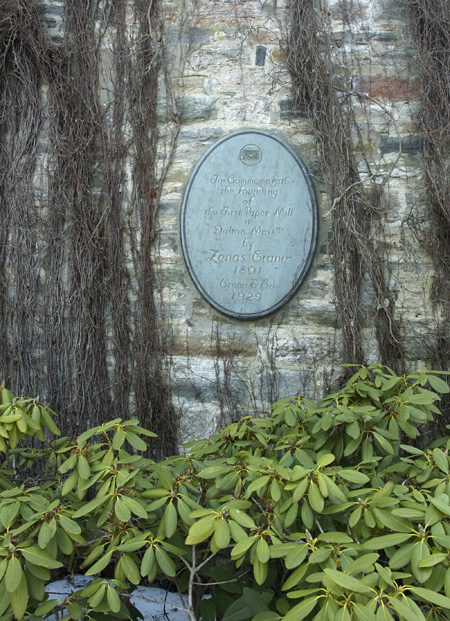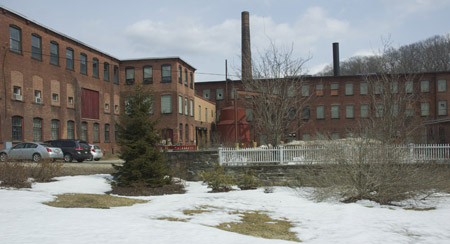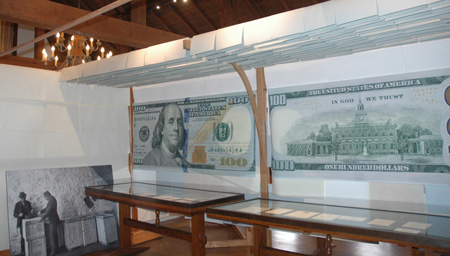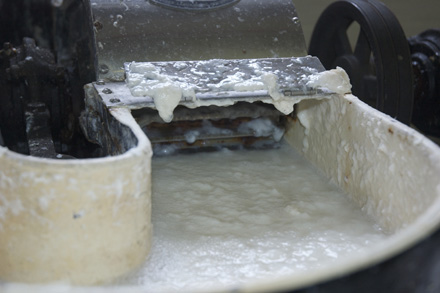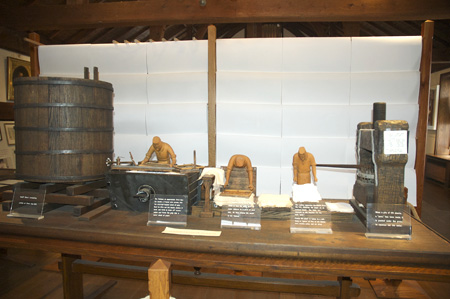You may have noticed from our last two posts (origami and marbled paper) that we are somewhat preoccupied with paper. That’s because the theme of the folk craft area at this summer’s Lowell Folk Festival is paper traditions. We’ve been seeking out craftspeople who fold, shape, cut, or use it as a medium for illumination or paint. Our travels have taken us to see origami artists Michael LaFosse and Richard Alexander of Origamido in Haverhill, and Regina and Dan St. John of Chena River Marblers in Amherst, professional paperhanger Heidi L. Johnson in Florence, Mexican piñata maker Angela Ortiz in Medford, and Polish wyncinanki (papercutting) Susan Urban in Springfield.
In addition to featuring folk and occupational traditions that use paper as a medium, we hope to have people on hand demonstrating the art of hand papermaking. Back in February, we reached out to author Nicholas Basbane, author of On Paper: The Everything of Its Two Thousand Year History, who shared all sorts of good leads. One of them was paper historian Peter Hopkins, who works at the Crane Museum of Papermaking in Dalton, Massachusetts. I drove to the Berkshires to meet with him at the museum, which is housed in Crane’s Old Stone Mill.
This 1844 building originally served as the rag room for the paper mill, and is located conveniently by the Housatonic River. Here, employees spent their days cutting large pieces of cotton and linen rags into smaller pieces, preparing them to be transformed into pulp. The fast moving river water not only served to wash the rags, it also powered the industrial machinery used in beating fibers into pulp.
Sourcing cotton and linen rags remains a critical part of the manufacturing process. I had never thought about the derivation of the term “rag man,” until Peter explained the way things used to be, circa 1810. Mill owners were responsible for gathering and paying for rags from nearby towns. “Your shirt wore out, you’d use it as a rag. Rag wore out, you’d sell it to the rag man. Rag man sells it to the papermaker.”
If you are of a certain age, you might associate the name Crane with elegant stationery (which the company still manufactures), but it is the making of paper used to print currency that is Crane’s bread and butter. Today, currency paper represents about half of Crane’s production. The family business, which dates back to 1770, is currently owned and run by the eighth generation of Cranes. It has been the sole source of US currency paper since 1879.
Stop and think about that.
Every single bill of US currency circulating around the globe right now was printed on paper made in this small corner of northwest Massachusetts.
Today, Crane paper is made from waste fibers re-claimed from cotton ginning and linen making operations. No trees are involved and never were. The papermaking process involves taking a blend of cotton and linen and literally beating them into a pulp. This takes place in a number of large manufacturing mill buildings on the Crane property. For demonstration purposes, Peter has some pulp that’s being beaten in a small mechanical beater and he takes me to a nearby work room to see it operating. We look down into the cream-of-wheat-like liquid. “At this point, the pulp is about 85% water. For papermaking, you want to dilute it to where it’s about 99% water. It randomizes fibers.”
Scooping up several cups full of the pulp, he walks it over to the other side of the room where he demonstrates the process of papermaking. After dumping the pulp into a rectangular vat, he picks up a screen and dips it into the liquid pulp and then lifts it up. “Whether you do this by machine or by hand, the next step is suction.” A small vacuum sucks the water away from the screen.”When the character of this changes, that’s the scientific moment when pulp turns to paper.”
Since 1991, Crane’s currency paper is highly engineered. It is embedded with security threads, that are only visible in transmitted light.
United States paper money may not be pretty or colorful compared to other world currency, but it is extremely durable. In fact, specifications call for every bill to survive a minimum of 8,000 folds. “Well, Americans abuse their money, number one,” Peter points out. “Number two, it’s the world’s currency and so it has to circulate everywhere and in every kind of environment you can imagine.” He places a sample of handmade paper in a machine he calls the “fold tester” and flicks it on. The mechanism counts 2,700 folds before the paper tears. Next he places a piece of regular notebook paper in — and it only survives nine folds before coming apart. Point taken.
Before my visit is over, we go over to take a look at one of the museum’s treasures — a wonderful model of the papermaking process designed and built by papermaking authority, Dard Hunter.
I learn that, unfortunately, Peter Hopkins will not be available to demonstrate papermaking on the weekend of the Lowell Folk Festival, but he does have several suggestions about who I might contact next . . .



